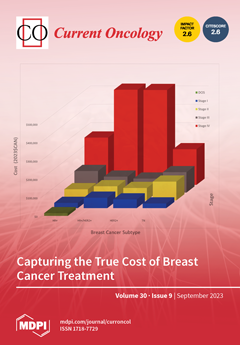The present study aimed to investigate the influence of the mutation abundance of the epidermal growth factor receptor (
EGFR) and its co-mutation with
TP53 on the therapeutic efficacy of tyrosine kinase inhibitor (TKI) treatment in patients with metastatic lung adenocarcinoma (LUAD).
[...] Read more.
The present study aimed to investigate the influence of the mutation abundance of the epidermal growth factor receptor (
EGFR) and its co-mutation with
TP53 on the therapeutic efficacy of tyrosine kinase inhibitor (TKI) treatment in patients with metastatic lung adenocarcinoma (LUAD). In total, 130 patients (January 2018-September 2022) with metastatic LUAD from the Second Affiliated Hospital of Zhejiang University were included. Kaplan–Meier analysis was performed to measure the duration of drug application (DDA) and the log-rank test was used to compare differences. Univariate and multivariate analyses of Cox proportional hazard regression models were used to evaluate the association between the relevant clinicopathological factors and DDA. Hazard ratios with 95% confidence intervals were also calculated. Among the 130 patients who were treated with first-generation
EGFR-TKIs, 86 showed high-
EGFR mutation abundance (>22.0%) and 44 showed low-
EGFR mutation abundance (≤22.0%). Patients in the high-
EGFR group had a greater DDA than those in the low-
EGFR group (
p < 0.05). The results of the subgroup analysis were consistent with those of the total mutation population (exon19: >18.5% vs. ≤18.5%, 14 months vs. 10 months,
p = 0.049; exon21: >22.0% vs. ≤22.0%, 15 months vs. 9 months,
p = 0.005). In addition, the mutation abundance of
TP53 was negatively correlated with the DDA (
p < 0.05). Patients in the combination group had a better DDA than those in the monotherapy group (
p < 0.05). Subgroup analysis showed that, among the low mutation abundance of the
EGFR exon 21 or 19 cohort, the combination group had a better DDA than the monotherapy group (
p < 0.05). An
EGFR mutation abundance greater than 22.0% was a positive predictor of DDA in patients with metastatic LUAD. However, a
TP53 mutation abundance higher than 32.5% could reverse this situation. Finally, first-line treatment with
EGFR-TKIs plus chemotherapy is a potential treatment strategy for patients with low-abundance
EGFR mutations.
Full article






